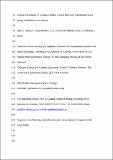Files in this item
Song hybridization events during revolutionary song change provide insights into cultural transmission in humpback whales
Item metadata
| dc.contributor.author | Garland, Ellen C. | |
| dc.contributor.author | Rendell, Luke | |
| dc.contributor.author | Lamoni, Luca | |
| dc.contributor.author | Poole, M. Michael | |
| dc.contributor.author | Noad, Michael J. | |
| dc.date.accessioned | 2018-01-25T00:31:45Z | |
| dc.date.available | 2018-01-25T00:31:45Z | |
| dc.date.issued | 2017-07-25 | |
| dc.identifier | 250524149 | |
| dc.identifier | 921667f3-9ae7-4d0e-b3c6-2befbc5d64d1 | |
| dc.identifier | 85025806270 | |
| dc.identifier | 000406189900045 | |
| dc.identifier.citation | Garland , E C , Rendell , L , Lamoni , L , Poole , M M & Noad , M J 2017 , ' Song hybridization events during revolutionary song change provide insights into cultural transmission in humpback whales ' , Proceedings of the National Academy of Sciences of the United States of America , vol. 114 , no. 30 , pp. 7822-7829 . https://doi.org/10.1073/pnas.1621072114 | en |
| dc.identifier.issn | 0027-8424 | |
| dc.identifier.other | ORCID: /0000-0002-8240-1267/work/49580219 | |
| dc.identifier.other | ORCID: /0000-0002-1121-9142/work/60428015 | |
| dc.identifier.uri | https://hdl.handle.net/10023/12604 | |
| dc.description | E.C.G. and this study were supported by a Newton International Fellowship from the Royal Society of London; L.L. was supported by Leverhulme Trust Research Project Grant RPG-2013-367; L.R. was supported by the Marine Alliance for Science and Technology for Scotland (MASTS) pooling initiative. MASTS is funded by the Scottish Funding Council (Grant HR09011) and contributing institutions. Song recordings in eastern Australia were funded by the Scott Foundation, the US Office of Naval Research, and the Australian Defence Science and Technology Organization. We thank everyone involved with this project. Some funding and logistical support was provided to M.M.P. by the US National Oceanic Society, Dolphin & Whale Watching Expeditions (French Polynesia), Vista Press, and the International Fund for Animal Welfare (via the South Pacific Whale Research Consortium). | en |
| dc.description.abstract | Cultural processes occur in a wide variety of animal taxa, from insects to cetaceans. The songs of humpback whales are one of the most striking examples of the transmission of a cultural trait and social learning in any nonhuman animal. To understand how songs are learned, we investigate rare cases of song hybridization, where parts of an existing song are spliced with a new one, likely before an individual totally adopts the new song. Song unit sequences were extracted from over 9,300 phrases recorded during two song revolutions across the South Pacific Ocean, allowing fine-scale analysis of composition and sequencing. In hybrid songs the current and new songs were spliced together in two specific ways: (i) singers placed a single hybrid phrase, in which content from both songs were combined, between the two song types when transitioning from one to the other, and/or (ii) singers spliced complete themes from the revolutionary song into the current song. Sequence analysis indicated that both processes were governed by structural similarity rules. Hybrid phrases or theme substitutions occurred at points in the songs where both songs contained “similar sounds arranged in a similar pattern.” Songs appear to be learned as segments (themes/phrase types), akin to birdsong and human language acquisition, and these can be combined in predictable ways if the underlying structural pattern is similar. These snapshots of song change provide insights into the mechanisms underlying song learning in humpback whales, and comparative perspectives on the evolution of human language and culture. | |
| dc.format.extent | 309338 | |
| dc.language.iso | eng | |
| dc.relation.ispartof | Proceedings of the National Academy of Sciences of the United States of America | en |
| dc.subject | Vocal learning | en |
| dc.subject | Cultural transmission | en |
| dc.subject | Song | en |
| dc.subject | Cetacean | en |
| dc.subject | Humpback whale | en |
| dc.subject | QH301 Biology | en |
| dc.subject | NDAS | en |
| dc.subject | BDC | en |
| dc.subject | R2C | en |
| dc.subject.lcc | QH301 | en |
| dc.title | Song hybridization events during revolutionary song change provide insights into cultural transmission in humpback whales | en |
| dc.type | Journal article | en |
| dc.contributor.sponsor | The Royal Society | en |
| dc.contributor.institution | University of St Andrews. School of Biology | en |
| dc.contributor.institution | University of St Andrews. Sea Mammal Research Unit | en |
| dc.contributor.institution | University of St Andrews. Centre for Social Learning & Cognitive Evolution | en |
| dc.contributor.institution | University of St Andrews. Marine Alliance for Science & Technology Scotland | en |
| dc.contributor.institution | University of St Andrews. Bioacoustics group | en |
| dc.contributor.institution | University of St Andrews. Centre for Biological Diversity | en |
| dc.identifier.doi | https://doi.org/10.1073/pnas.1621072114 | |
| dc.description.status | Peer reviewed | en |
| dc.date.embargoedUntil | 2018-01-24 | |
| dc.identifier.grantnumber | NF140667 | en |
This item appears in the following Collection(s)
Items in the St Andrews Research Repository are protected by copyright, with all rights reserved, unless otherwise indicated.

